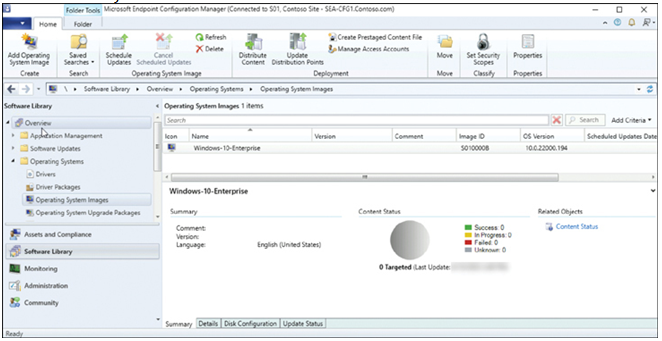Many organizations have relied on Configuration Manager to manage their operating system deployments and act as the core of their device management strategies. Although Configuration Manager, displayed in Figure 1-5, has been around for quite a while, it still plays a critical role, acting as a bridge between traditional and modern management. This is especially true for organizations managing hybrid devices (those joined to Azure AD and AD DS).

FIGURE 1-5 The Operating System Images node in the Software Library
Configuration Manager offers a wide range of services, including:
- Operating system deployment
- Application management
- Update and servicing management
- Device inventory
- Cloud management capability
- Advanced reporting capability
- Integration with Azure AD
- Integration with Desktop Analytics
- Remote control
- User state migration
The question is, can Configuration Manager help your organization with their Windows 11 deployment strategy, or are MDT or Intune sufficient? Configuration Manager uses boot and operating system images, much like MDT. It also supports capabilities that help deliver upgrade packages, device drivers, and operating system and software updates.
Configuration Manager also uses task sequences to complete a collection of actions. However, Configuration Manager extends these capabilities by supporting schedule-based deployments. This extends MDT’s lite-touch (LTI) deployment model to zero-touch installation (ZTI).
Configuration Manager uses task sequences to complete the following typical tasks:
- Deployment of:
- An operating system to a new or rebuilt device
- A Windows 11 upgrade
- Capturing an operating system image
- Migrating user state settings
Select a Windows edition based on requirements
When evaluating the Windows edition you will deploy, you should consider the business requirements because not all editions support all features. Editions offering more features will cost more, so you should consider the most appropriate edition to support your needs.
For example, not all Windows editions have the same built-in management features and settings. If you intend to manage devices using mobile device management (MDM) such as Microsoft Intune, you should consider Windows 11 Enterprise, which has full management features. Both Home and Pro editions have fewer management capabilities in Intune.
If your organization’s devices are fully working and running supported Windows 10 or Windows 11 devices, Microsoft recommends using an in-place upgrade strategy to deploy Windows 11 to the Windows 10 devices to preserve all the management settings after the upgrade.







Leave a Reply